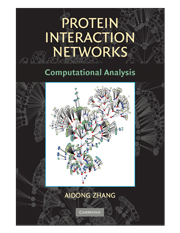Book contents
- Frontmatter
- Contents
- Preface
- 1 Introduction
- 2 Experimental Approaches to Generation of PPI Data
- 3 Computational Methods for the Prediction of PPIs
- 4 Basic Properties and Measurements of Protein Interaction Networks
- 5 Modularity Analysis of Protein Interaction Networks
- 6 Topological Analysis of Protein Interaction Networks
- 7 Distance-Based Modularity Analysis
- 8 Graph-Theoretic Approaches to Modularity Analysis
- 9 Flow-Based Analysis of Protein Interaction Networks
- 10 Statistics and Machine Learning Based Analysis of Protein Interaction Networks
- 11 Integration of GO into the Analysis of Protein Interaction Networks
- 12 Data Fusion in the Analysis of Protein Interaction Networks
- 13 Conclusion
- Bibliography
- Index
11 - Integration of GO into the Analysis of Protein Interaction Networks
Published online by Cambridge University Press: 28 January 2010
- Frontmatter
- Contents
- Preface
- 1 Introduction
- 2 Experimental Approaches to Generation of PPI Data
- 3 Computational Methods for the Prediction of PPIs
- 4 Basic Properties and Measurements of Protein Interaction Networks
- 5 Modularity Analysis of Protein Interaction Networks
- 6 Topological Analysis of Protein Interaction Networks
- 7 Distance-Based Modularity Analysis
- 8 Graph-Theoretic Approaches to Modularity Analysis
- 9 Flow-Based Analysis of Protein Interaction Networks
- 10 Statistics and Machine Learning Based Analysis of Protein Interaction Networks
- 11 Integration of GO into the Analysis of Protein Interaction Networks
- 12 Data Fusion in the Analysis of Protein Interaction Networks
- 13 Conclusion
- Bibliography
- Index
Summary
INTRODUCTION
The ability of the various approaches discussed throughout this book to accurately analyze protein-protein interactions (PPIs) is often compromised by the errors and gaps that characterize the data. Their accuracy would be enhanced by the integration of data from all available sources. Modern experimental and computational techniques have resulted in the accumulation of massive amounts of information about the functional behavior of biological components and systems. These diverse data sources have provided useful insights into the functional association between components. The following types of data have frequently been drawn upon for functional analysis and could be integrated with PPI data [276, 297, 304, 305]:
Amino acid sequences
Protein structures
Genomic sequences
Phylogenetic profiles
Microarray expressions
Gene Ontology (GO) annotations
The development of sequence similarity search algorithms such as FASTA [244], BLAST [13], and PSI-BLAST [14] has been a major breakthrough in the field of bioinformatics. The algorithms rest on the understanding that proteins with similar sequences are functionally consistent. Searching for sequential homologies among proteins can facilitate their classification and the accurate prediction of their functions.
The availability of complete genomes for various organisms has shifted such sequence comparisons from the level of the single gene to the genome level [48, 97]. As discussed in Chapter 3, several genome-scale approaches have been introduced on the basis of the correlated evolutionary mechanisms of genes. For example, the conservation of gene neighborhoods across different, distantly-related genomes reveals potential functional linkages [80, 235, 296]. Gene fusion analysis infers pairs of interacting proteins and their functional relatedness [98, 208].
- Type
- Chapter
- Information
- Protein Interaction NetworksComputational Analysis, pp. 216 - 242Publisher: Cambridge University PressPrint publication year: 2009



